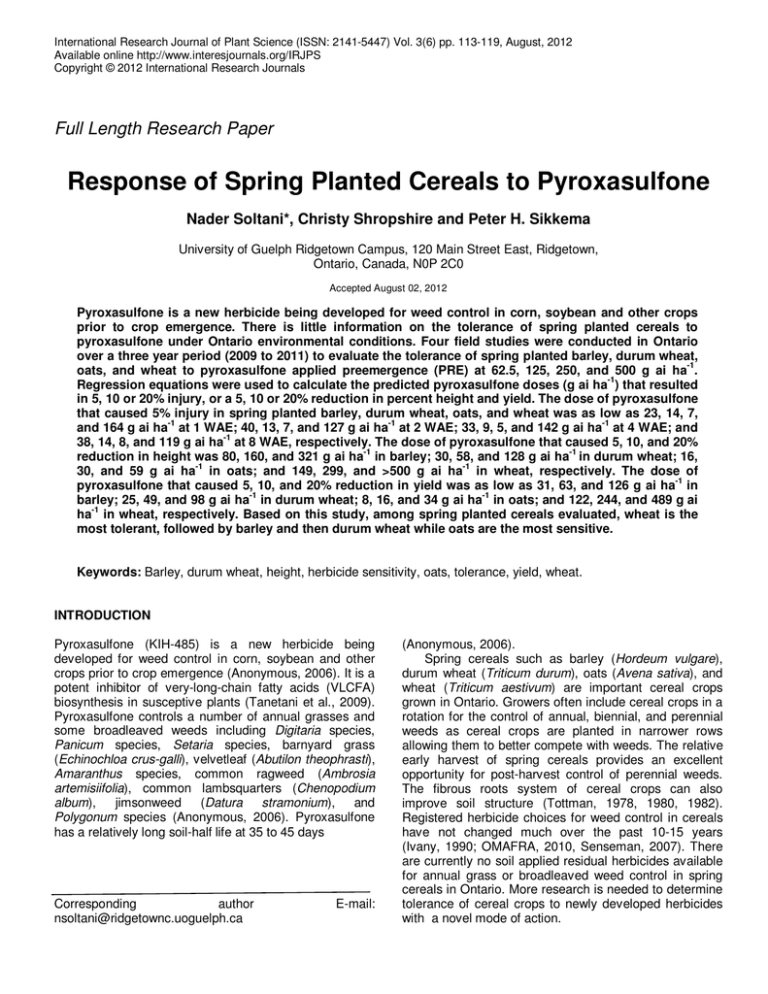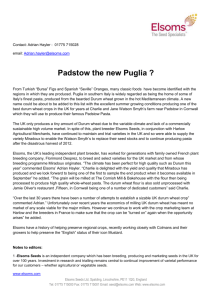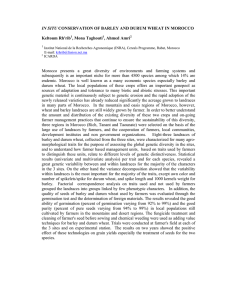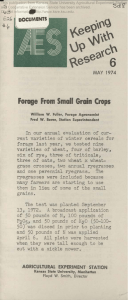Document 14258176
advertisement

International Research Journal of Plant Science (ISSN: 2141-5447) Vol. 3(6) pp. 113-119, August, 2012 Available online http://www.interesjournals.org/IRJPS Copyright © 2012 International Research Journals Full Length Research Paper Response of Spring Planted Cereals to Pyroxasulfone Nader Soltani*, Christy Shropshire and Peter H. Sikkema University of Guelph Ridgetown Campus, 120 Main Street East, Ridgetown, Ontario, Canada, N0P 2C0 Accepted August 02, 2012 Pyroxasulfone is a new herbicide being developed for weed control in corn, soybean and other crops prior to crop emergence. There is little information on the tolerance of spring planted cereals to pyroxasulfone under Ontario environmental conditions. Four field studies were conducted in Ontario over a three year period (2009 to 2011) to evaluate the tolerance of spring planted barley, durum wheat, oats, and wheat to pyroxasulfone applied preemergence (PRE) at 62.5, 125, 250, and 500 g ai ha-1. Regression equations were used to calculate the predicted pyroxasulfone doses (g ai ha-1) that resulted in 5, 10 or 20% injury, or a 5, 10 or 20% reduction in percent height and yield. The dose of pyroxasulfone that caused 5% injury in spring planted barley, durum wheat, oats, and wheat was as low as 23, 14, 7, and 164 g ai ha-1 at 1 WAE; 40, 13, 7, and 127 g ai ha-1 at 2 WAE; 33, 9, 5, and 142 g ai ha-1 at 4 WAE; and 38, 14, 8, and 119 g ai ha-1 at 8 WAE, respectively. The dose of pyroxasulfone that caused 5, 10, and 20% reduction in height was 80, 160, and 321 g ai ha-1 in barley; 30, 58, and 128 g ai ha-1 in durum wheat; 16, -1 -1 30, and 59 g ai ha in oats; and 149, 299, and >500 g ai ha in wheat, respectively. The dose of pyroxasulfone that caused 5, 10, and 20% reduction in yield was as low as 31, 63, and 126 g ai ha-1 in barley; 25, 49, and 98 g ai ha-1 in durum wheat; 8, 16, and 34 g ai ha-1 in oats; and 122, 244, and 489 g ai ha-1 in wheat, respectively. Based on this study, among spring planted cereals evaluated, wheat is the most tolerant, followed by barley and then durum wheat while oats are the most sensitive. Keywords: Barley, durum wheat, height, herbicide sensitivity, oats, tolerance, yield, wheat. INTRODUCTION Pyroxasulfone (KIH-485) is a new herbicide being developed for weed control in corn, soybean and other crops prior to crop emergence (Anonymous, 2006). It is a potent inhibitor of very-long-chain fatty acids (VLCFA) biosynthesis in susceptive plants (Tanetani et al., 2009). Pyroxasulfone controls a number of annual grasses and some broadleaved weeds including Digitaria species, Panicum species, Setaria species, barnyard grass (Echinochloa crus-galli), velvetleaf (Abutilon theophrasti), Amaranthus species, common ragweed (Ambrosia artemisiifolia), common lambsquarters (Chenopodium album), jimsonweed (Datura stramonium), and Polygonum species (Anonymous, 2006). Pyroxasulfone has a relatively long soil-half life at 35 to 45 days Corresponding author nsoltani@ridgetownc.uoguelph.ca E-mail: (Anonymous, 2006). Spring cereals such as barley (Hordeum vulgare), durum wheat (Triticum durum), oats (Avena sativa), and wheat (Triticum aestivum) are important cereal crops grown in Ontario. Growers often include cereal crops in a rotation for the control of annual, biennial, and perennial weeds as cereal crops are planted in narrower rows allowing them to better compete with weeds. The relative early harvest of spring cereals provides an excellent opportunity for post-harvest control of perennial weeds. The fibrous roots system of cereal crops can also improve soil structure (Tottman, 1978, 1980, 1982). Registered herbicide choices for weed control in cereals have not changed much over the past 10-15 years (Ivany, 1990; OMAFRA, 2010, Senseman, 2007). There are currently no soil applied residual herbicides available for annual grass or broadleaved weed control in spring cereals in Ontario. More research is needed to determine tolerance of cereal crops to newly developed herbicides with a novel mode of action. 114 Int. Res. J. Plant Sci. There is little information available on tolerance of pyroxasulfone in spring cereals under Ontario environmental conditions. If tolerance is adequate, pyroxasulfone would provide Ontario cereal growers with a new, low-use-rate herbicide that provides full-season residual control of annual grasses and selected broadleaved weeds. Furthermore, if used in a diversified, integrated weed management program it can reduce the selection intensity for herbicide resistant weeds. The objective of this research was to evaluate the tolerance of spring planted barley, durum wheat, oats, and wheat to pyroxasulfone applied preemergence (PRE) -1 at 62.5, 125, 250, and 500 g ai ha . MATERIALS AND METHODS Four field studies were conducted at the Huron Research Station, Exeter, Ontario over a three-year period (one site in 2009 and 2010 and two sites in 2011). The soil at the study sites was a Brookston clay loam. Seedbed preparation consisted of moldboard plowing in the autumn followed by two passes with a cultivator with rolling basket harrows in the spring. The study was established as a split-plot design with four replications. Main plots were type of spring cereal (barley, durum wheat, oats, and wheat) and subplots were dose of pyroxasulfone applied PRE (0, 62.5, 125, 250, and 500 g ai ha-1). Spring planted barley ‘Bornholm’, durum wheat ‘Hallmark’, oats ‘Sherwood’ and wheat ‘Hobson’ were seeded with a double disc drill at 140 kg ha-1 in rows spaced 17.5 cm apart at a depth of 4 cm in late April. Pyroxasulfone was applied within 3 days of seeding with a CO2 pressurized backpack sprayer calibrated to deliver 200 L ha-1 at 240 kPa. The boom was 1.5 m long with four Hypro ULD120-02 nozzle tips (Hypro, New Brighton, MN, USA) spaced 50 cm apart. All plots including the non-treated control were kept weed-free by hand weeding. Visible crop injury was rated on a scale of 0 to 100% (0=no visible injury, and 100=plant death) at 1, 2, 4, and 8 weeks after emergence (WAE). Ten plants were randomly selected per plot and the height from the soil surface to the highest growing point of each plant was measured at 5 WAE. All cereals were harvested in late July using a plot combine and yields were adjusted to 14.8, 14.5, 13.5, and 14.0% moisture for barley, durum wheat, oats and wheat, respectively. PROC NLIN (non-linear regression) procedure of SAS (2008). PROC MIXED Cereal type, pyroxasulfone rate and their interaction were considered fixed effects, while random effects included environment (year) and its interaction with fixed effects, and replicate nested within environment. Environments were combined for contrasts and the regression analysis if the environment by rate by cereal type interaction was not significant. There was zero injury in 2010 at 3 days after emergence (DAE) and 1 WAE for all cereal types and at 2 WAE for durum, oats and wheat. These could not be combined with any other environment for the given variables. Contrasts (in PROC MIXED) were used to compare a cereal type to each other across all rates combined. To satisfy assumptions of normality, all injury except 2 WAE in 2010 were arcsine square root transformed. For each variable, cereal types were ranked in order of tolerance to pyroxasulfone. PROC REG and NLIN If the cereal type by rate interaction was significant in PROC MIXED (which it was for all variables), separate regressions were run for each cereal type. Regression equations that best fit the data were chosen for each variable, cereal type and environment combination. Regression equations (models) used (parameters were regressed against pyroxasulfone rate, designated as RATE in the equations) Injury, percent height and yield (linear): [1] Y = a + b * RATE where a is the intercept and b is the slope. Injury (exponential to maximum): [2] Y = c + d (1 – exp (-e * RATE)) where c is the intercept, d is the magnitude constant and e is the rate constant. Injury (exponential): [3] Y = f * exp (g *RATE) where f is the magnitude constant, and g is the rate constant. Statistical Analysis All data were subjected to analysis of variance. Tests were combined over locations and years and analyzed using PROC MIXED, PROC REG (linear regression), and Percent height and yield [inverse exponential (Chism et al. 1992)]: [4] Y = h + j * exp (-k * RATE) Soltani et al. 115 Table 1. Exponential to maximum and exponential parameters (±SE) for spring cereal injury 1 WAE at Exeter, Ontario (2009-2011).a Pyroxasulfone rate Cereal Year(s) type Exponential to maximum Regression Parameters (± ±SE) c d Barley Durum Oats Exponential Wheat 0 0 0 f 0.002 c 2009, 2011 2009, 2011 2009, 2011 2009, 2011 (0) (0) (0) 66.8 96.0 99.5 g 1.50 (0.003) R5 e (15.0) (11.5) (3.9) 0.0034 0.0038 0.0069 (0.0014) (0.0009) (0.0055) (0.24) R10 -1 g ai ha b R20 23 14 7 47 29 15 104 61 32 164 261 414 d Pyroxasulfone tolerance Wheat > Barley = Durum > Oats 2009, 2011 a Abbreviations: SE, standard error; WAE, weeks after crop emergence. b R5, R10 and R20 are the rates required to cause 5, 10, and 20% injury, respectively, for a given cereal type. c Exponential to maximum corresponds to equation 2 and exponential corresponds to equation 3. Exponential to maximum parameters: c, intercept; d, magnitude constant; e, rate constant. Exponential parameters: f, magnitude constant; g, rate constant. d Highest tolerance to lowest, based on results of contrasts. Table 2. Linear, exponential to maximum and exponential parameters (±SE) for spring cereal injury 2 WAE at Exeter, Ontario (2009-2011).a Cereal type Linear Barley Pyroxasulfone rateb Year(s) c (0.002) >500 R10 g ai ha-1 >500 2009, 2011 Exponential to maximum 0 c (0) 0.125 d (0.006) 40 80 160 Durum Oats 2009, 2011 2009, 2011 0 0 (0) (0) 99.8 98.0 (8.0) (2.7) 13 7 26 14 55 30 Exponential Wheat 2009, 2011 f 0.006 (0.006) g 1.38 (0.16) 127 210 348 2010 2010 2009, 2011 Regression Parameters (± ±SE) a b 0 (0) 0.009 R5 R20 >500 e 0.0041 0.0076 (0.0027) (0.0006) Pyroxasulfone toleranced Wheat = Durum = Oats > Barley Wheat > Barley > Durum > Oats a Abbreviations: SE, standard error; WAE, weeks after crop emergence. R5, R10 and R20 are the rates required to cause 5, 10, and 20% injury, respectively, for a given cereal type. c Linear corresponds to equation 1, exponential to maximum corresponds to equation 2 and exponential corresponds to equation 3. Linear parameters: a, intercept; b, slope. Exponential to maximum parameters: c, intercept; d, magnitude constant; e, rate constant. Exponential parameters: f, magnitude constant; g, rate constant. d Highest tolerance to lowest, based on results of contrasts. b where h is the lower asymptote, j is the reduction in Y from intercept to h, and k is the slope. RESULTS AND DISCUSSION Regression equations were used to calculate predicted pyroxasulfone rates (g ai ha-1) that resulted in 5, 10 or 20% injury (R5, R10, R20), or a 5, 10 or 20% reduction in percent height and yield (R95, R90, R80). If the predicted pyroxasulfone rate was higher than the highest evaluated rate (500 g ai ha-1) then it was expressed as “>500” because it would not be proper to extrapolate outside the rate range evaluated in these experiments. At 1 WAE, the predicted dose of pyroxasulfone that caused 5, 10, and 20% injury was 23, 47, and 104 g ai 116 Int. Res. J. Plant Sci. Table 3. Linear, exponential to maximum and exponential parameters (±SE) for spring cereal injury 4 WAE at Exeter, Ontario (2009-2011).a Cereal type Linear Barley Durum Oats b Year(s) 2010 2009, 2011 2010 2010 Wheat 2010 Exponential to maximum Durum 2009, 2011 Oats 2009, 2011 Exponential Wheat 2009, 2011 2010 2009, 2011 (0.001) (0.005) (0.002) (0.003) Pyroxasulfone rate R5 R10 R20 -1 g ai ha 295 >500 >500 33 67 133 132 263 >500 110 220 441 (0.001) 472 >500 >500 9 5 19 10 41 22 142 222 346 c Regression Parameters (± ±SE) a b 0 (0) 0.017 0 (0) 0.150 0 (0) 0.038 0 (0) 0.045 0 c 0 0 f 0.002 (0) (0) (0) (0.002) 0.011 d 99.2 95.2 g 1.55 (3.8) (1.9) (0.16) e 0.0055 0.0106 (0.0005) (0.0006) Pyroxasulfone toleranced Wheat = Barley > Durum > Oats Wheat > Barley > Durum > Oats a Abbreviations: SE, standard error; WAE, weeks after crop emergence. b R5, R10 and R20 are the rates required to cause 5, 10, and 20% injury, respectively, for a given cereal type. c Linear corresponds to equation 1, exponential to maximum corresponds to equation 2 and exponential corresponds to equation 3. Linear parameters: a, intercept; b, slope. Exponential to maximum parameters: c, intercept; d, magnitude constant; e, rate constant. Exponential parameters: f, magnitude constant; g, rate constant. d Highest tolerance to lowest, based on results of contrasts. ha-1 in barley; 14, 29, and 61 g ai ha-1 in durum wheat; 7, 15, and 32 g ai ha-1 in oats; and 164, 261, and 414 g ai ha-1 in wheat, respectively (Table 1). At 2 WAE, the predicted dose of pyroxasulfone that caused 5, 10, and 20% injury ranged 40 to >500, 80 to >500, and 160 to >500 g ai ha-1 in barley; 13, 26, and 55 -1 -1 g ai ha in durum wheat; 7, 14, and 30 g ai ha in oats; -1 and 127, 210, and 348 g ai ha in wheat, respectively (Table 2). At 4 WAE, the predicted dose of pyroxasulfone that caused 5, 10, and 20% injury ranged 33 to 295, 67 to >500, and 133 to >500 g ai ha-1 in barley; 9 to 132, 19 to 263, and 41 to >500g ai ha-1 in durum wheat; 5 to 110, 10 -1 to 220, and 22 to 441 g ai ha in oats; and 142 to 472, 222 to >500, and 346 to >500 g ai ha-1 in wheat, respectively (Table 3). At 8 WAE, the predicted dose of pyroxasulfone that caused 5, 10, and 20% injury ranged 38 to 174, 75 to -1 348, and 151 to >500 g ai ha in barley; 14 to 74, 29 to -1 148, and 61 to 296 g ai ha in durum wheat; 8 to 32, 16 to 65, and 35 to 130 g ai ha-1 in oats; and 119 to >500, -1 217 to >500, and 395 to >500 g ai ha in wheat, respectively (Table 4). For all injury ratings spring wheat was generally more tolerant to pyroxasulfone than spring barley followed by spring durum wheat followed by spring oats. The level of injury observed with the PRE application of pyroxasulfone in this study was higher than the level of injury found with many currently used POST herbicides in Ontario such as 2,4-D, MCPA, dichlorprop plus 2,4-D, and bromoxynil plus MCPA (OMAFRA, 2010; Sikkema et al., 2007; Soltani et al., 2006). Height The predicated dose of pyroxasulfone that caused 5, 10, and 20% reduction in height was 80, 160, and 321 g ai ha-1 in barley; 30, 58, and 128 g ai ha-1 in durum wheat; 16, 30, and 59 g ai ha-1 in oats; and 149, 299, and >500 g -1 ai ha in wheat, respectively (Table 5). Generally, wheat and barley had a similar level of tolerance to pyroxasulfone followed by durum wheat followed by oats. In other studies, there was no difference between barley, oats and wheat to PRE application of safluenacil and mesotrione or POST application 2,4-D amine, bromoxynil plus MCPA, and dichlorprop plus 2,4D under Ontario environmental conditions (OMAFRA, 2010; Sikkema et al., 2007, 2008; Soltani et al. 2011). Height reduction of 16% have been shown in some cereals with commonly used herbicides such as dicamba, dicamba plus MCPA plus mecoprop, dicamba plus 2,4-D amine, dicamba plus MCPA and saflufenacil (Martin et al., 1989; Quimby and Nalewaja, 1966; Sikkema et al., 2007, 2008). Soltani et al. 117 Table 4. Linear, exponential to maximum and exponential parameters (±SE) for spring cereal injury 8 WAE at Exeter, Ontario (2009-2011).a Cereal type Linear Barley Durum Oats b Year(s) 2010 2009, 2011 2010 2010 Pyroxasulfone rate R10 R20 R5 g ai ha-1 174 348 >500 38 75 151 74 148 296 32 65 130 c Regression Parameters (± ±SE) a b 0 (0) 0.029 0 (0) 0.133 0 (0) 0.068 0 (0) 0.154 Wheat 2010 Exponential to maximum Durum 2009, 2011 Oats 2009, 2011 Exponential 0 c 0 0 f (0) Wheat 2009, 2011 0.020 2010 2009, 2011 Pyroxasulfone toleranced Wheat > Barley > Durum > Oats Wheat > Barley > Durum > Oats (0) (0) (0.016) (0.002) (0.005) (0.004) (0.006) 0.009 d 100.0 100.0 g (0.001) 1.16 (0.13) e 0.0037 0.0064 (0) (0) (0.0002) (0.0003) >500 >500 >500 14 8 29 16 61 35 119 217 395 a Abbreviations: SE, standard error; WAE, weeks after crop emergence. R5, R10 and R20 are the rates required to cause 5, 10, and 20% injury, respectively, for a given cereal type. c Linear corresponds to equation 1, exponential to maximum corresponds to equation 2 and exponential corresponds to equation 3. Linear parameters: a, intercept; b, slope. Exponential to maximum parameters: c, intercept; d, magnitude constant; e, rate constant. Exponential parameters: f, magnitude constant; g, rate constant. d Highest tolerance to lowest, based on results of contrasts. b Table 5. Linear and inverse exponential parameters (±SE) for spring cereal height 5 WAE as a percent of the untreated check at Exeter, Ontario (2009-2011).a Cereal type Year(s) Linear Barley 2009-2011 Wheat 2009-2011 Inverse exponential Durum 2009-2011 Oats 2009-2011 Regression Parameters (± ±SE) a b 100 (0) -0.062 100 (0) -0.034 h j 49.4 (6.2) 51.4 18.1 (5.6) 83.6 2009-2011 Pyroxasulfone toleranced Wheat = Barley > Durum > Oats Pyroxasulfone rateb R95 R90 R80 g ai ha-1 80 160 321 149 299 >500 c (0.005) (0.005) (5.8) (5.5) k 0.0040 0.0051 (0.0011) (0.0009) 30 16 58 30 128 59 a Abbreviations: SE, standard error; WAE, weeks after crop emergence. R95, R90 and R80 are the rates required to cause 5, 10, and 20% height reduction, respectively, for a given cereal type. c Linear corresponds to equation 1and inverse exponential corresponds to equation 4. Linear parameters: a, intercept; b, slope. Inverse exponential parameters:h, lower asymptote; j, reduction in Y from intercept to h; k, slope. d Highest tolerance to lowest, based on results of contrasts. b Yield The predicted dose of pyroxasulfone that caused 5, 10, and 20% reduction in yield was 31 to >500, 63 to >500, and 126 to >500 g ai ha-1 in barley; 25 to 62, 49 to 124, and 98 to 248 g ai ha-1 in durum wheat; 8 to 31, 16 to 63, -1 and 34 to 126 g ai ha in oats; and 122 to >500, 244 to >500, and 489 to >500 g ai ha-1 in wheat, respectively (Table 6). Generally, wheat was more tolerant to pyroxasulfone than barley followed by durum wheat followed by oats. In other studies, there was no difference in yield of barley, oats and wheat to the PRE application of saflufenacil (Sikkema et al. 2008) and mesotrione (Soltani et al. 118 Int. Res. J. Plant Sci. Table 6. Linear and inverse exponential parameters (±SE) for spring cereal yield as a percent of the untreated check at Exeter, Ontario (20092011).a Cereal type Linear Barley b Year(s) 2010 2009, 2011 Wheat 2010 2009, 2011 Durum 2010 2009, 2011 Oats 2010 Inverse exponential Oats 2009, 2011 2010 2009, 2011 Pyroxasulfone rate R95 R90 R80 -1 g ai ha >500 >500 >500 31 63 126 >500 >500 >500 122 244 489 62 124 248 25 49 98 31 63 126 c Regression Parameters (± ±SE) a b 100 (0) -0.009 100 (0) -0.159 100 (0) -0.003 100 (0) -0.041 100 (0) -0.081 100 (0) -0.204 100 (0) -0.159 h j 0.0 (3.7) 100.0 (0.009) (0.013) (0.005) (0.007) (0.007) (0.008) (0.007) (0) k 0.0066 (0.0010) 8 16 34 Pyroxasulfone toleranced Wheat = Barley > Durum > Oats Wheat > Barley = Durum > Oats a Abbreviations:SE, standard error. R95, R90 and R80 are the rates required to cause 5, 10, and 20% yield reduction, respectively, for a given cereal type. c Linear corresponds to equation 1and inverse exponential corresponds to equation 4. Linear parameters: a, intercept; b, slope. Inverse exponential parameters:h, lower asymptote; j, reduction in Y from intercept to h; k, slope. d Highest tolerance to lowest, based on results of contrasts. b 2011) which is similar to the yield response of cereals to currently used POST herbicides such as 2,4-D amine, bromoxynil plus MCPA, and dichlorprop plus 2,4-D (OMAFRA, 2010; Sikkema et al., 2007). CONCLUSIONS Pyroxasulfone (125 g ha-1) applied preemergence results in unacceptable yield loss in spring planted barley, oats and durum wheat. Pyroxasulfone applied preemergence at the low rate has potential for use in spring planted wheat. Generally, wheat was more tolerant to pyroxasulfone than barley followed by durum wheat followed by oats. ACKNOWLEDGEMENTS The authors acknowledge Todd Cowan for his expertise and technical assistance in these studies. Funding for this project was provided in part by the Grain Farmers of Ontario and Kumiai America. REFERENCES Anonymous (2006). KIH-485 experimental herbicide. Kumiai Chemical Industry Co., LTD. 11 Martine Avenue, Suite 970, White Plains, NY. 10606. 8 p. Chism WJ, Birch JB, Bingham SW (1992). Nonlinear regressions for analyzing growth stage and quinclorac interactions. Weed Technol. 6:898-903. Ivany JA, Nass HG, Sanderson JB (1990). Effect of time of application of herbicides on yield of three winter wheat cultivars. Can. J. Plant Sci. 70:605-609. Martin DA, Miller SD, Alley HP (1989). Winter wheat (Triticum aestivum) response to herbicides applied at three growth stages. Weed Technol. 3:90-94. [OMAFRA] Ontario Ministry of Agriculture, Food, and Rural Affairs (2010). Guide to Weed Control. Publication 75. Toronto, ON: Ontario Ministry of Agriculture, Food, and Rural Affairs. Quimby PC Jr., Nalewaja JD (1966). Effect of dicamba on wheat and wild buckwheat at various stages of development. Weeds, 14:229232. [SAS] Statistical Analysis Systems (2008). The SAS system. Version 9.2. Cary, NC: Statistical Analysis Systems Institute. Senseman SA (2007). Herbicide Handbook, Ninth Edition. Champaign, IL: Weed Sci. Soc. Am., 458 pp. Sikkema PH, Brown L, Shropshire, C, Soltani N (2007). Responses of three types of winter wheat (Triticum aestivum L.) to spring-applied post-emergence herbicides. Crop Prot. 26:715-720. Sikkema PH, Shropshire C, Soltani N (2008). Tolerance of spring barley (Hordeum vulgare), oats (Avena sativa) and wheat (Triticum aestivum L.) to saflufenacil. Crop Prot. 27:1495-1497. Soltani N, Shropshire C, Sikkema PH (2006). Responses of winter wheat (Triticum aestivum L.) to autumn applied post-emergence herbicides. Crop Prot. 25:346-349. Soltani N, Shropshire C, Sikkema PH (2011). Response of spring barley (Hordeum Vulgare L.), oats (Avena sativa L.) and wheat (Triticum aestivum L.) to mesotrione. Crop Prot. 30:849-853. Tanetani Y, Kaku K, Kawai K, Fujioka T, Shimizu T (2009). Action mechanism of a novel herbicide, pyroxasulfone. Pesticide Biochemistry and Physiology 95:47-55. Soltani et al. 119 Tottman DR (1978). The effects of a dicamba herbicide mixture on the grain yield components of winter wheat. Weed Res. 18:335-339. Tottman DR (1980). Varietal differences in the tolerance of cereals to herbicides. Winter wheat, Crop Conference, p. 68. Tottman DR (1982). The effects of broad - leaved weed herbicides applied to cereal crops at different growth stages. Aspects of Applied Biology I:broad-leaved weeds and their control in cereals, University of Warwick,England.Pp.201-210.






